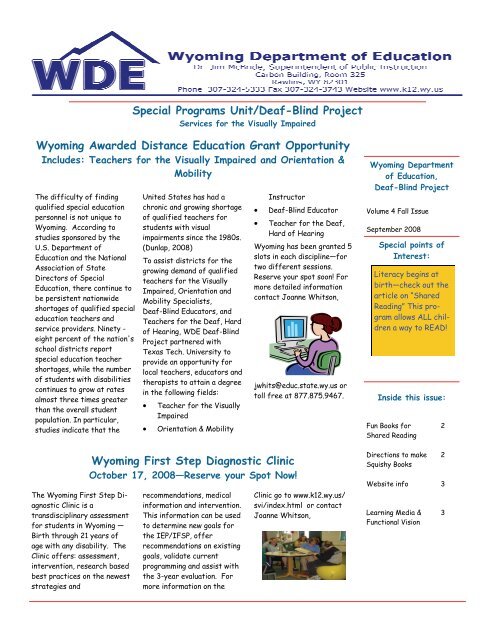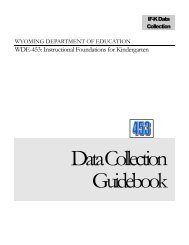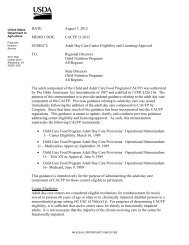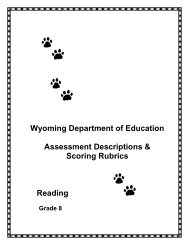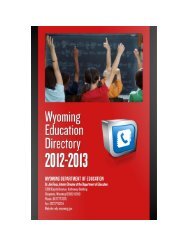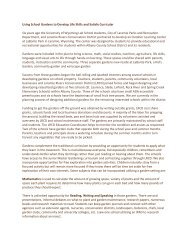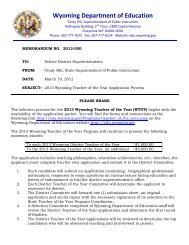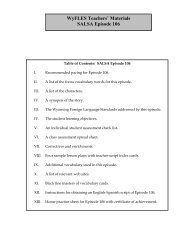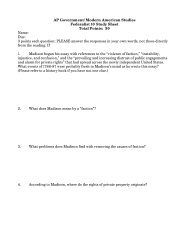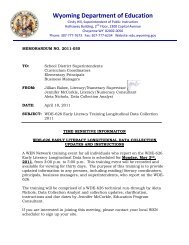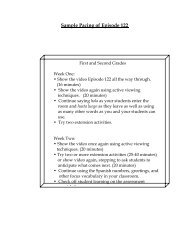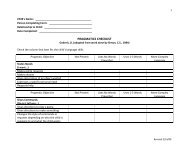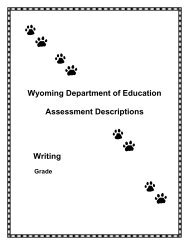Fall 2008 - Shared Reading Strategies - Wyoming Department of ...
Fall 2008 - Shared Reading Strategies - Wyoming Department of ...
Fall 2008 - Shared Reading Strategies - Wyoming Department of ...
You also want an ePaper? Increase the reach of your titles
YUMPU automatically turns print PDFs into web optimized ePapers that Google loves.
The difficulty <strong>of</strong> finding<br />
qualified special education<br />
personnel is not unique to<br />
<strong>Wyoming</strong>. According to<br />
studies sponsored by the<br />
U.S. <strong>Department</strong> <strong>of</strong><br />
Education and the National<br />
Association <strong>of</strong> State<br />
Directors <strong>of</strong> Special<br />
Education, there continue to<br />
be persistent nationwide<br />
shortages <strong>of</strong> qualified special<br />
education teachers and<br />
service providers. Ninety -<br />
eight percent <strong>of</strong> the nation's<br />
school districts report<br />
special education teacher<br />
shortages, while the number<br />
<strong>of</strong> students with disabilities<br />
continues to grow at rates<br />
almost three times greater<br />
than the overall student<br />
population. In particular,<br />
studies indicate that the<br />
The <strong>Wyoming</strong> First Step Diagnostic<br />
Clinic is a<br />
transdisciplinary assessment<br />
for students in <strong>Wyoming</strong> —<br />
Birth through 21 years <strong>of</strong><br />
age with any disability. The<br />
Clinic <strong>of</strong>fers: assessment,<br />
intervention, research based<br />
best practices on the newest<br />
strategies and<br />
Special Programs Unit/Deaf-Blind Project<br />
Services for the Visually Impaired<br />
<strong>Wyoming</strong> Awarded Distance Education Grant Opportunity<br />
Includes: Teachers for the Visually Impaired and Orientation &<br />
Mobility<br />
United States has had a<br />
chronic and growing shortage<br />
<strong>of</strong> qualified teachers for<br />
students with visual<br />
impairments since the 1980s.<br />
(Dunlap, <strong>2008</strong>)<br />
To assist districts for the<br />
growing demand <strong>of</strong> qualified<br />
teachers for the Visually<br />
Impaired, Orientation and<br />
Mobility Specialists,<br />
Deaf-Blind Educators, and<br />
Teachers for the Deaf, Hard<br />
<strong>of</strong> Hearing, WDE Deaf-Blind<br />
Project partnered with<br />
Texas Tech. University to<br />
provide an opportunity for<br />
local teachers, educators and<br />
therapists to attain a degree<br />
in the following fields:<br />
• Teacher for the Visually<br />
Impaired<br />
• Orientation & Mobility<br />
<strong>Wyoming</strong> First Step Diagnostic Clinic<br />
October 17, <strong>2008</strong>—Reserve your Spot Now!<br />
recommendations, medical<br />
information and intervention.<br />
This information can be used<br />
to determine new goals for<br />
the IEP/IFSP, <strong>of</strong>fer<br />
recommendations on existing<br />
goals, validate current<br />
programming and assist with<br />
the 3-year evaluation. For<br />
more information on the<br />
Instructor<br />
• Deaf-Blind Educator<br />
• Teacher for the Deaf,<br />
Hard <strong>of</strong> Hearing<br />
<strong>Wyoming</strong> has been granted 5<br />
slots in each discipline—for<br />
two different sessions.<br />
Reserve your spot soon! For<br />
more detailed information<br />
contact Joanne Whitson,<br />
jwhits@educ.state.wy.us or<br />
toll free at 877.875.9467.<br />
Clinic go to www.k12.wy.us/<br />
svi/index.html or contact<br />
Joanne Whitson,<br />
<strong>Wyoming</strong> <strong>Department</strong><br />
<strong>of</strong> Education,<br />
Deaf-Blind Project<br />
Volume 4 <strong>Fall</strong> Issue<br />
September <strong>2008</strong><br />
Special points <strong>of</strong><br />
Interest:<br />
Literacy begins at<br />
birth—check out the<br />
article on “<strong>Shared</strong><br />
<strong>Reading</strong>” This program<br />
allows ALL children<br />
a way to READ!<br />
Inside this issue:<br />
Fun Books for<br />
<strong>Shared</strong> <strong>Reading</strong><br />
Directions to make<br />
Squishy Books<br />
2<br />
2<br />
Website info 3<br />
Learning Media &<br />
Functional Vision<br />
3
<strong>Shared</strong> reading is a technique that<br />
emphasizes conversation between a<br />
child and the reader about different<br />
aspects <strong>of</strong> the story. This powerful<br />
technique can account for at least 10%<br />
<strong>of</strong> the variance among reading and<br />
non-reading children (Ezell & Justice,<br />
2005). Good shared reading supports<br />
children to ask and answer questions<br />
and to make comments about each page<br />
<strong>of</strong> a book. Effective shared reading also<br />
includes readers who can ask<br />
appropriate questions, wait for answers,<br />
and who make comments and<br />
connections regarding the story and the<br />
print on each page to meaningful words<br />
and events in the child’s life (Ezell &<br />
Justice, 2005).<br />
Ingredients:<br />
• Several heavy-duty, freezer -<br />
quality, Ziploc bags (1 quart size)<br />
• “Squishy” materials such as<br />
alcohol-free hair gel (variety <strong>of</strong><br />
colors), hand-lotion (with and without<br />
glitter), “gak” ( water and corn<br />
starch with food coloring),<br />
vegetable oil and food coloring,<br />
sand, dirt, paper strips/packaging<br />
materials, etc.<br />
• Small plastic letters, objects<br />
• Clear packaging tape<br />
Page 2<br />
Fun Books for SHARED <strong>Reading</strong><br />
Patsy Pierce, Ph. D. The Center for Literacy and Disability Studies,<br />
The University <strong>of</strong> North Carolina at Chapel Hill<br />
<strong>Shared</strong> reading is <strong>of</strong>ten difficult for<br />
children with disabilities due to the<br />
high level <strong>of</strong> language that is shared and<br />
expected during a conversation<br />
(Kaderavek & Sulzby, 1998).<br />
Appropriate scaffolding techniques<br />
used by the communication partner<br />
along with augmentative and alternative<br />
means for the child to participate are<br />
required (Dale, Crain-Thoreson,<br />
Notari-Syverson, & Cole, 1996). Pierce<br />
and Erickson (2006) list several<br />
suggestions <strong>of</strong> appropriate interaction<br />
techniques (e.g., pausing, using gestures<br />
and pictures) to use with children with<br />
disabilities.<br />
Interesting books may also facilitate<br />
longer engagement and enhanced<br />
<strong>Shared</strong> <strong>Reading</strong>: Directions to Make Squishy Books<br />
A sample squishy book<br />
participation during shared reading with<br />
children with disabilities. Building on<br />
children’s interests has been found to<br />
be an effective approach to enhance<br />
engagement and learning (Dunst, 2006).<br />
Children with disabilities may<br />
demonstrate typical topic-related<br />
interests (e.g., puppies, babies), but may<br />
also demonstrate less topic-related and<br />
more sensory-related interests (e.g.,<br />
sounds, vibration, textures). Family -<br />
members, teachers, and service providers<br />
may discover varying topic and/<br />
or sensory-related interests by<br />
observing children with<br />
disabilities in different<br />
settings and with different<br />
types <strong>of</strong> materials.<br />
<strong>Shared</strong> <strong>Reading</strong> Sensory Books: Increase Student Literacy Participation<br />
Children were more likely to interact<br />
with books and participate during<br />
shared reading if we made books out <strong>of</strong><br />
materials that reflected the children’s<br />
sensory interests. We added text to<br />
the books related to the children, their<br />
friends, and their family interests. The<br />
following <strong>of</strong>fers descriptions <strong>of</strong> how to<br />
make some <strong>of</strong> the books that we have<br />
found children with significant<br />
disabilities to enjoy and explore during<br />
shared reading.<br />
Several children with cognitive, motor,<br />
and sensory impairments with whom we<br />
have worked, seemed to enjoy squeezing<br />
“squishy” materials such as play-dough,<br />
putty, and even their diapers. We used<br />
this interest to make “squishy books” to<br />
give the children appropriate options to<br />
explore their interests, to learn to turn<br />
pages, and to participate in shared<br />
reading. As children make comments, or<br />
adults could come up with simple<br />
phrases related to the pages in the<br />
book, these comments are written on<br />
“sticky notes” and attached to each<br />
page and used as text.<br />
Fill a Ziploc bag (page) with something<br />
“squishy”. Before closing the bag, add<br />
small objects like plastic animals and<br />
plastic letters that might spell the<br />
name <strong>of</strong> the animal into the bag. Zip it<br />
shut. After filling several bags, tape<br />
the zippered-parts together with<br />
packaging tape to make a book. Usually<br />
3-4 pages can be securely taped<br />
together. Now you have a book that a<br />
student can enjoy while using a<br />
multitude <strong>of</strong> senses.<br />
Special Programs Unit/Deaf-Blind Project
Animal food books: Pages filled with<br />
different types <strong>of</strong> animal foods, (e.g.,<br />
dry dog food, dry cat food, bird seed,<br />
hay) and with the logo/label from the<br />
food container. You may have to use a<br />
sample-size <strong>of</strong> the animal food to have<br />
the right size <strong>of</strong> the label/logo to put in<br />
the baggie with the food.<br />
Breakfast food books: Pages filled with<br />
different types <strong>of</strong> cereal along with the<br />
label/logo from the box <strong>of</strong> cereal. It is<br />
helpful to use “snack-size” boxes <strong>of</strong><br />
cereal in order to have the right size<br />
label to put in each bag. White paper<br />
strips could also be added as “milk” for<br />
the cereal. We found that puncturing<br />
the bags with a needle in several places<br />
help the pages to remain flat.<br />
Sand books: Pages filled with sand,<br />
seashells, sea-horses, and letters to<br />
spell these words. Children with visual<br />
The National Braille<br />
Press has created a national<br />
children’s Braille<br />
literacy program to<br />
encourage families with<br />
blind children to read print/Braille<br />
books together.<br />
The Read Books! Program is giving away<br />
bags containing: An age-appropriate<br />
One <strong>of</strong> the first questions asked about<br />
a child's learning is what his/her primary<br />
reading medium will be. Teachers<br />
and parents may be uncertain as to<br />
whether a child should learn Braille, rely<br />
on large print, auditory modalities or<br />
use regular print for accessing reading<br />
material. The purpose <strong>of</strong> the Learning<br />
Media Assessment, LMA, is to determine<br />
the most effective medium for<br />
accessing instruction and teaching<br />
methods. A certified teacher <strong>of</strong> students<br />
with visual impairments completes<br />
this assessment. The LMA covers both<br />
Volume 4 <strong>Fall</strong> Issue<br />
<strong>Shared</strong> <strong>Reading</strong>—Variations on the theme: Other Types <strong>of</strong> Books<br />
impairments <strong>of</strong>ten seemed to interact<br />
more with these books when glitter was<br />
mixed with the sand.<br />
Dirt books: Pages filled with potting<br />
soil, plastic insects, worms, and letters<br />
to spell related words.<br />
ABC book: Pages filled with a plastic<br />
letter and small objects starting with<br />
that letter, (e.g., B, bug, baby, ball). The<br />
pages also have a fun substance in them<br />
like hair gel.<br />
Name book: Each page has a plastic<br />
letter and items that begin with that<br />
letter from a child’s name, (e.g., P, pig,<br />
next page, A-ant, next page, T-tiger,<br />
next page, S -soap, last page, Y-yellow<br />
gel). All pages haves different fun<br />
squishy stuff in them.<br />
Wallpaper/Fabric Sample Books<br />
Wallpaper/Fabric Sample books are<br />
Websites in the Spotlight<br />
print/Braille book (birth– 7 years) in<br />
English or Spanish:<br />
♦ A Braille primer for sighted parents<br />
♦ A colorful print/Braille place mat<br />
♦ Print/Braille bookmarks<br />
♦ A guide for parents on why and<br />
how to read books with their young<br />
blind child<br />
general learning media and literacy media.<br />
One <strong>of</strong> the first areas to be examined<br />
is the student’s ability to use their<br />
vision. This can be determined through<br />
a Functional Vision Assessment, FVA.<br />
This is <strong>of</strong> special importance when programming<br />
for students with visual impairments.<br />
Successfully educating these<br />
students depends upon access to accurate,<br />
current information about each<br />
child's use <strong>of</strong> his/her vision. The FVA<br />
complements information available from<br />
an ophthalmologist or optometrist regarding<br />
medical diagnosis, care, prognosis,<br />
and health <strong>of</strong> the visual system.<br />
made from old sample books by gluing<br />
objects, pictures, and text on each<br />
page. These books are heavy enough to<br />
remain stable for ease in page turning<br />
and hold up to much moisture and rough<br />
usage. The colors and textures are<br />
interesting to many children.<br />
Children enjoying wall paper and fabric<br />
sample books<br />
Photo provided by Patsy Pierce<br />
Article reprinted with permission from<br />
the Nevada Dual Sensory Impairment<br />
Project • Winter <strong>2008</strong> Newsletter •<br />
Volume 17, Number 2<br />
♦A gift coupon redeemable for another<br />
print/Braille book or Braille/large print<br />
playing cards<br />
♦ Print / Braille magnetic Letters<br />
To request your bag and learn more<br />
about the importance<br />
<strong>of</strong> emergent literacy in early childhood<br />
for children with vision impairments,<br />
visit their website:<br />
Learning Media Assessment & Functional Vision Assessments Offered by WDE<br />
In order to assist districts with performing<br />
these mandatory assessments,<br />
WDE will be piloting a Low Vision Assessment/<br />
Functional Vision Assessment<br />
and learning Media Assessment as part<br />
<strong>of</strong> the <strong>Wyoming</strong> First Step Diagnostic<br />
Clinic. The first assessments will be<br />
held during the Spring Clinic. If you<br />
are interested, contact Joanne<br />
Whitson, 877-875-9467.<br />
Page 3
<strong>Wyoming</strong> <strong>Department</strong> <strong>of</strong><br />
Education,<br />
Deaf-Blind Project<br />
Carbon Building Room 325<br />
215 West Buffalo<br />
Rawlins, WY 82301<br />
Phone: 307.324.5333 or Toll Free<br />
877.875.9675<br />
Fax: 307.324.3743<br />
Finding Answers Together<br />
For more information on <strong>Shared</strong><br />
<strong>Reading</strong> or literacy strategies—<br />
April 23—25, 2009<br />
Western Regional Early Intervention<br />
Conference! Watch the<br />
web for information,<br />
www.k12.wy.us/svi/index.html<br />
<strong>Wyoming</strong> <strong>Department</strong> <strong>of</strong> Education<br />
<strong>Wyoming</strong> Deaf-Blind Project<br />
Carbon Building Room 325<br />
215 West Buffalo<br />
Rawlins, WY 82301<br />
<strong>Wyoming</strong> Awarded the Deaf-Blind Grant<br />
<strong>2008</strong>—2013<br />
The mission <strong>of</strong> the <strong>Wyoming</strong> Deaf-Blind Project is to<br />
ensure that all students in <strong>Wyoming</strong> who are deaf-blind<br />
receive the appropriate support and tools enabling them<br />
to achieve both academic success to improve results in<br />
school and go on to become contributing members <strong>of</strong><br />
their community. In order to meet this mission, the<br />
project foci is to better identify children birth through<br />
21 years <strong>of</strong> age who are deaf-blind; provide a<br />
comprehensive array <strong>of</strong> technical assistance, information,<br />
training and support throughout <strong>Wyoming</strong> to families,<br />
support staff, educators, early interventionists, aids and<br />
therapists in activities that are supported by<br />
scientifically based research for working with children<br />
who are deaf-blind and engage in ongoing leadership and<br />
collaboration with state and national agencies. For more<br />
information on the grant contact Joanne Whitson,<br />
877.875.9467.<br />
<strong>Wyoming</strong> <strong>Department</strong> <strong>of</strong> Education does not discriminate on the basis <strong>of</strong> race, color, national origin, sex, age, or disability in admission or access to, or<br />
treatment <strong>of</strong> employment in its programs or activities. Inquiries concerning Title VI, Title IX, Section 504, and ADA may be referred to <strong>Wyoming</strong> <strong>Department</strong> <strong>of</strong><br />
Education, Office for Civil Rights Coordinator, 2300 Capitol Ave., Cheyenne, WY, 82002-0050 or 307-777-7673, or the Office <strong>of</strong> Civil Rights, Region VIII, U. S.


